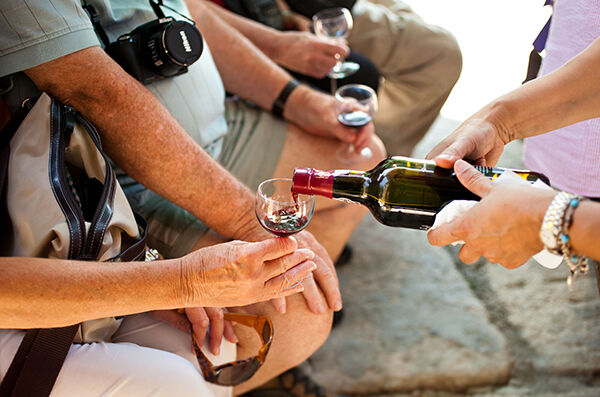Savoring the Scenery — and Port — of Portugal’s Douro Valley
Slow down amid the sublime hillsides that line the Douro River, where wine is still made by hand (and foot).
By Rick Steves

One of Portugal's most endearing slices is the Douro River Valley, the winding, terraced region that produces the country's beloved port wine. Unlike the Rhine, Loire, and many of Europe's great rivers, the Douro was never a strategic military location. So, rather than castles and stony ramparts, visitors encounter farms and sleepy villages. The only thing fortified here…is the wine.
The Douro region stretches along the river of the same name, about 60 miles inland from the city of Porto. (The second largest city in Portugal, Porto is where the Douro River spills into the Atlantic Ocean.) Joy-riding through the region you enjoy steep, twisting valleys and tidy terraces as far as the eye can see. Depending on when you visit, the hillside can shift in color, from dusty brown in winter, to scrubby green in summer, to glowing red and gold in fall.
The Douro Valley is the only place in the world that can legally produce what's called "port wine." Visiting here, you can appreciate just how much hard work it was, and still is, to produce traditional port wine. Generation after generation, rugged farmers gradually turned these hillsides into vast terraces expertly crafted to let grape vines draw water from below and sun from above. To this day, the production of port remains a labor of love, as grapes are still generally picked by hand and crushed the traditional way — by foot — since machines are unable to achieve high-quality results.
Since port wine is a blend of several types of grapes, most port-producing vineyards, called quintas, grow a few different varieties of grapes. Unlike traditional wine, which undergoes fermentation in full, port is a fortified wine. During fermentation, brandy is added to port wine, thereby halting the process and preserving some of the sugars from the grapes. This is what gives port its signature sweetness.
The best way to fully experience the Douro Valley is to rent a car to visit several quintas. While some are private, many welcome travelers (and some rent rooms). Of the quintas that are open to the public, most offer a one-hour tour, followed by a tasting of several wines. Since some tastings are by prior arrangement only, it's smart to call ahead. That said, it's fairly informal — drivers can simply pull into any quinta marked rota do vinho do Porto and ask for a taste. If they're not too busy, you may even be treated to a short tour.
Without a car, a slow but scenic way to visit is to take a boat from Porto to the heart of the Douro (a seven-hour trip). Trains run between Porto and the two main towns in the region: Peso da Régua and Pinhão. Neither town is particularly exciting, but both have hotels and make a decent home base for visiting the area's quintas.
Régua, which feels more urban and functional of the two hubs, is home to two main streets and the Douro Museum, with exhibits that explain the landscape, industry, culture, and geology of the region. A rabelo — the traditional flat-bottomed boat that was once used to transport barrels of port downriver from Douro to Porto — is permanently moored to the rooftop. Pinhão — even smaller than Régua, with just one main street — feels more deeply rooted in Douro culture and scenery.
Compare quintas with the help of a guidebook, online research, or local advice. One good place is Quinta do Panascal, which produces the popular Fonseca port. Though a commercial operation, it feels special thanks to its tucked-away location — and because it's one of the few places that lets visitors roam free among its terraced vineyards.
But my favorite ones to visit are the small and family-run quintas, where you get the chance to meet the latest generation of winemakers and appreciate the pride of these artisans, so passionate about their traditions and craft. I particularly like the welcoming, family-run Quinta de la Rosa near Pinhão.
If you have time, it's worthwhile to spend a night or two at a quinta. You'll be welcomed like a guest in a local family's home, and you get to savor the beautiful countryside right outside your window. It's a memorable experience, and the best way to gain an appreciation for this wonderfully drinkable bit of Portuguese culture.

